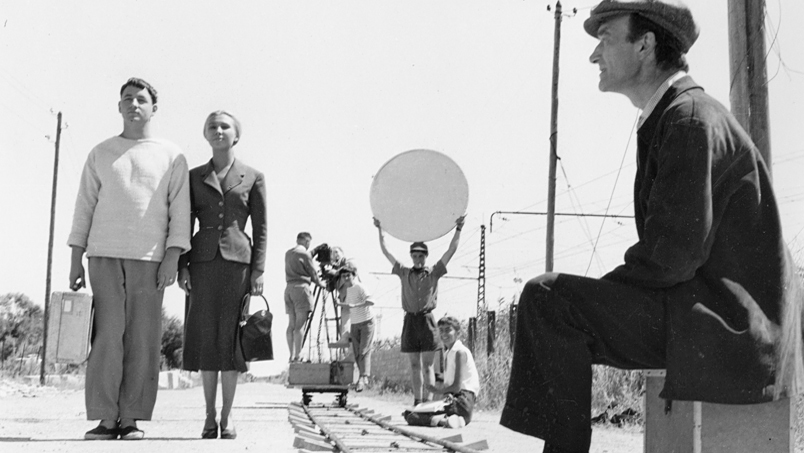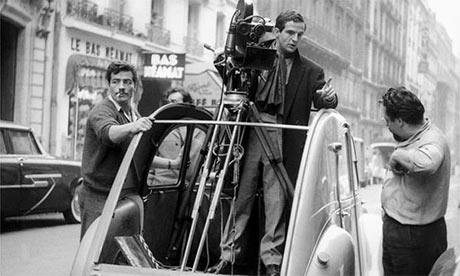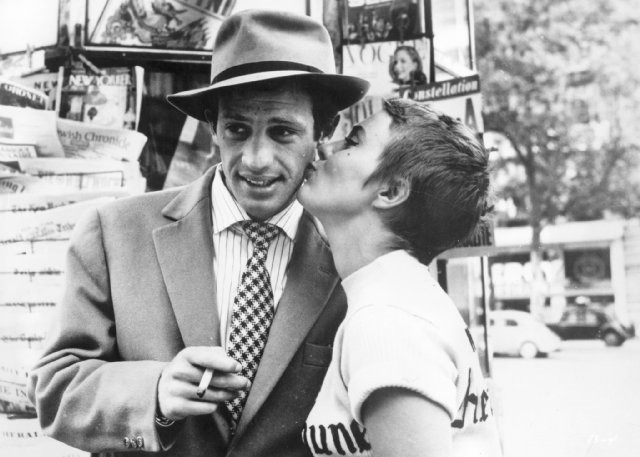French New Wave Cinema of 1950s, 1960s
The New Wave (French: La Nouvelle Vague) was a blanket term coined by critics for a group of French filmmakers of the late 1950s and 1960s, influenced by Italian Neorealism and classical Hollywood cinema. Although never a formally organized movement, the New Wave filmmakers were linked by their self-conscious rejection of classical cinematic form and their spirit of youthful iconoclasm. "New Wave" is an example of European art cinema. Many also engaged in their work with the social and political upheavals of the era, making their radical experiments with editing, visual style and narrative part of a general break with the conservative paradigm. Using portable equipment and requiring little or no set up time, the New Wave way of filmmaking presented a documentary type style. The films exhibited direct sounds on film stock that required less light. Filming techniques included fragmented, discontinuous editing, and long takes. The combination of objective realism, subjective realism, and authorial commentary created a narrative ambiguity in the sense that questions that arise in a film are not answered in the end.Who
were the new wave?
- Period of many “new waves”
- Britain
- French movement most influential, focus on Paris
- Group of French Filmmakers:
Jean-Luc Goddard
Francois Truffaut
Claude Chabrol
Jacques Rivette
Eric Rohmer
- All once film critics, background in film theory
- All wrote for Cahiers du Cinema
La Pointe Courte (1954), by Agnes Varda – Starts off the New Wave

>>> Interesting piece on La Pointe Courte and how Agnes Varda invented the New Wave <<<
http://www.criterion.com/current/posts/497-la-pointe-courte-how-agnes-varda-invented-the-new-wave
The French New Wave
and European art cinema, post-1960
- Jean-Luc Godard, Breathless (1960)
- The French New Wave: Godard andFrançois Truffaut
- Italy in the 1960s: Federico Fellini, Michaelangelo Antonioni, Pier Paolo Pasolini
- Other countries: Ingmar Bergman (Sweden), Luis Buñuel (return to Franceand Spain)
The French New Wave
(late 1950s-early 1960s)
- Period of many “new waves”
- Britain
- French movement most influential, focus on Paris
- Group of French Filmmakers:
Jean-Luc Goddard
Francois Truffaut
Claude Chabrol
Jacques Rivette
Eric Rohmer
- All once film critics, background in film theory
- All wrote for Cahiers du Cinema
La Pointe Courte (1954), by Agnes Varda – Starts off the New Wave

>>> Interesting piece on La Pointe Courte and how Agnes Varda invented the New Wave <<<
http://www.criterion.com/current/posts/497-la-pointe-courte-how-agnes-varda-invented-the-new-wave
The French New Wave
and European art cinema, post-1960
- Jean-Luc Godard, Breathless (1960)
- The French New Wave: Godard andFrançois Truffaut
- Italy in the 1960s: Federico Fellini, Michaelangelo Antonioni, Pier Paolo Pasolini
- Other countries: Ingmar Bergman (Sweden), Luis Buñuel (return to Franceand Spain)
The French New Wave
(late 1950s-early 1960s)
- Henri Langlois and the Paris Cinemateque
- Andre Bazin and the realist tradition
- Cahiers du Cinema
- From Critics to Auteurs
- Against the "Cinema of Quality"
- Discovery of American genre films
- Cinematic, rather than literary, values
- Importance of personal expression
- Spontaneity and digression
Truffaut
at work, 1964
Francois Truffaut at work, photographed by Carole Le Berre
'By the time he was shooting La Peau Douce (Soft Skin) in 1964, François Truffaut had changed cinema forever. His debut, 1959's The 400 Blows, had won him the award for best director at Cannes and, alongside the films of fellow Nouvelle Vague directors Jean-Luc Godard and Jacques Demy, introduced a new style in which naturalism was favoured over theatricality and the director became sole author of his or her creation. Out went expensive sets and lavish costumes; in came character-led snapshots of life shot on low budgets with small crews. This scene of Truffaut filming La Peau Douce is pure Nouvelle Vague: a lightweight camera, mounted onto a modified 2 CV and filming in daylight on the streets of Paris, as opposed to an artificially lit shoot in a studio, with a dolly on a track.
La Peau Douce dealt with a preoccupation that Truffaut returned to again and again, one that he knew intimately: infidelity. It tells the story of a middle-aged lecturer who falls for Françoise Dorléac's icily beautiful air hostess, leading to the break-up of his marriage. Scenes were shot in an apartment owned by Truffaut's wife, the daughter of a successful retailer whose wealth allowed the director to have the freedom to make films independently. Truffaut was himself having an affair with Dorléac - who was to die in a car crash three years later - at the time.
Dorléac was in good company. Truffaut often fell in love with his leading ladies, and had affairs with Jeanne Moreau, Fanny Ardant and Dorléac's sister, Catherine Deneuve - whose rejection of him, after the 1969 film Mississippi Mermaid, led to his nervous breakdown.
Critic George Perry met Truffaut soon after La Peau Douce was completed. "Truffaut was determined," he sys. "He knew exactly what he wanted to do and he had a better grasp of his medium than Jean-Luc Godard. He understood exactly what made a film look good."Will Hodgkinson'
Article from The Guardian
French New Wave: existentialism
(Philosopher Jean Paul Sartre (1905-1980)
(Philosopher Jean Paul Sartre (1905-1980)
- Stressed the individual
- Experience of free choice
- Absence of any rational understanding of universe
- Sense of absurdity in human life
- Indifferent world, existentialist seeks to:
Act authentically
Use free will
Take responsibility for all their actions
Avoid playing out roles pre-ordained by society
- French New Wave: the "look"
- Shot on location
- Used lightweight, hand-held cameras
- Lightweight sound and lighting equipment
- Faster film stocks, less light
- Films shot cheaply and quickly
- Encouraged experimentation and improvisation
- Casual, natural look
- Available light, sound
- Mise-en-scene, French landscape, cafes
- Mobile camera, improvised and innovative
Reacting against french film of 1940s
(cinéma du
papa)
- Against films shot in a studio
- Against films that were set in the past
- Against films that were contrived and over-dramatised
- Against films that used trickery and special effects
- Against la tradition de qualite
La Belle et la Bête Jean COCTEAU 1946

Reacting against french film of 1940s
(cinéma du
papa)
- Against films shot in a studio
- Against films that were set in the past
- Against films that were contrived and over-dramatised
- Against films that used trickery and special effects
- Against la tradition de qualite
La Belle et la Bête Jean COCTEAU 1946
Beauty and the Beast (French: La Belle et la Bête) is a 1946 French romantic fantasy film adaptation of the traditional fairy tale of the same name, written by Jeanne-Marie Le Prince de Beaumont and published in 1757 as part of a fairy tale anthology (Le Magasin des Enfants, ou Dialogues entre une sage gouvernante et ses élèves, London 1757). Directed by French poet and filmmaker Jean Cocteau, the film stars Josette Day as Belle and Jean Marais. It is widely considered one of the finest fantasy films of all time. (wiki)
The new wave celebrated American film noir because it reflected contemporary
urban life
Characters
in contemporary dress, speaking in the vernacular
Breathless
Jean-Luc
Godard (1930- )
- Reinventing film from the ground up
- Basis in American gangster films, but everything is de-glamourised
- Location shooting, natural light, handheld camera
- Use of jump cuts, mismatches, and other violations of continuity editing rules
- Self-reflexivity: Jean-Paul Belmondo and Bogart
- Jean Seberg: America/France
- USe of digressions and suspensions of action
- Reality of story/reality of film
- Ambiguities of character, of identification, of ending
French New Wave: the editing style
- Freestyle
- Did not conform to editing rules
- Discontinuous
- Jump cuts
- Insertion of extraneous material
- Shooting on location, natural lighting, improvised dialogue and plotting direct sound recording, long takes, many of these conventions
OVERAL GOAL = to make the audience remember that they are watching a movie
French New Wave: mood shifts
- Heroes are aimless, stylish, act silly yet they are cowardly and amoral
- Mood shifts:
Infatuation
Romanticism
Boredom
- About death and betrayal
Godard: influence
- Jump cuts
- Elasticity of time
- Montage, beyond Eisenstein
- Relative independence of sound and image
- Focus on both narration and narrated
- Self-reflexive cinema
- "Reality of images"
Cleo 5 to 7, Varda (1963)
- Shot for $64,000 and financed by the New Wave producers Beauregard and Ponti through their Rome-Paris film company
- Still contained the essential features of New Wave film:
Shot in the day
Black and white
35mm
Using real locations
Naturalistic light
Real time





No comments:
Post a Comment